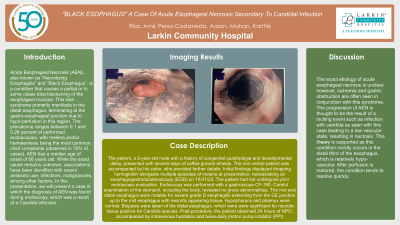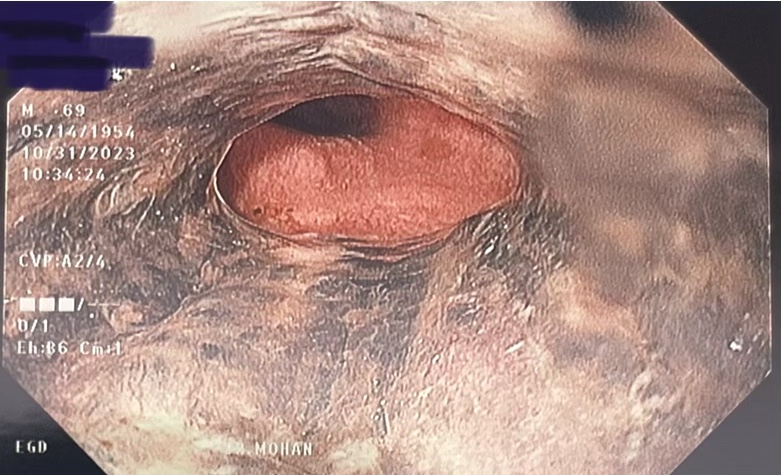Sunday Poster Session
Category: Esophagus
P0550 - Acute Esophageal Necrosis Resulting From Candida Infection
Sunday, October 27, 2024
3:30 PM - 7:00 PM ET
Location: Exhibit Hall E

Has Audio
- AP
Aaron Perez, DO
Larkin Community Hospital
South Miami, FL
Presenting Author(s)
Aaron Perez, DO, Amir Riaz, MD
Larkin Community Hospital, South Miami, FL
Introduction: Acute Esophageal Necrosis (AEN), also known as “Necrotizing Esophagitis” and “Black Esophagus”, is a condition that causes a partial or in some cases total blackening of the esophageal mucosa. This rare syndrome primarily manifests in the distal esophagus, terminating at the gastro-esophageal junction due to hypo-perfusion in this region. The prevalence ranges between 0.1 and 0.28 percent of performed endoscopies, with melena and/or hematemesis being the most common chief complaints (observed in 70% of cases). AEN has a median age of onset of 68 years old. While the exact cause remains unknown, associations have been identified with recent antibiotic use, infections, malignancies, among other factors. In this presentation, we will present a case in which the diagnosis of AEN was found during endoscopy, which was a result of a Candida infection.
Case Description/Methods: The patient, a 69-year-old male with a history of congenital quadriplegia and developmental delay, presented with several days of coffee ground emesis. The non-verbal patient was accompanied by his sister, who provided further details. Initial findings displayed dropping hemoglobin alongside multiple episodes of melena at presentation, necessitating an esophagogastroduodenoscopy (EGD) on 10/31/23. The patient had not undergone prior endoscopic evaluation. Endoscopy was performed with a gastroscope CF-190. Careful examination of the stomach, including the body, revealed no gross abnormalities. The mid and distal esophagus were notable for severe grade D esophagitis extending from the GE junction up to the mid esophagus with necrotic appearing tissue. Hypopharynx and pharnyx were normal. Biopsies were taken of the distal esophagus, which were were significant for necrotic tissue positive for Candida species. Post-procedure, the patient observed 24 hours of NPO, accompanied by intravenous hydration and twice-daily proton pump inhibitor (PPI) administration.
Discussion: The exact etiology of acute esophageal necrosis is unclear, however, ischemia and gastric obstruction are often seen in conjunction with this syndrome. The progression of AEN is thought to be the result of a inciting event such as infection with candida as seen with this case leading to a low vascular state, resulting in necrosis. This theory is supported as this condition mostly occurs in the distal third of the esophagus, which is relatively hypo-vascular. After perfusion is restored, the condition tends to resolve quickly.

Disclosures:
Aaron Perez, DO, Amir Riaz, MD. P0550 - Acute Esophageal Necrosis Resulting From Candida Infection, ACG 2024 Annual Scientific Meeting Abstracts. Philadelphia, PA: American College of Gastroenterology.
Larkin Community Hospital, South Miami, FL
Introduction: Acute Esophageal Necrosis (AEN), also known as “Necrotizing Esophagitis” and “Black Esophagus”, is a condition that causes a partial or in some cases total blackening of the esophageal mucosa. This rare syndrome primarily manifests in the distal esophagus, terminating at the gastro-esophageal junction due to hypo-perfusion in this region. The prevalence ranges between 0.1 and 0.28 percent of performed endoscopies, with melena and/or hematemesis being the most common chief complaints (observed in 70% of cases). AEN has a median age of onset of 68 years old. While the exact cause remains unknown, associations have been identified with recent antibiotic use, infections, malignancies, among other factors. In this presentation, we will present a case in which the diagnosis of AEN was found during endoscopy, which was a result of a Candida infection.
Case Description/Methods: The patient, a 69-year-old male with a history of congenital quadriplegia and developmental delay, presented with several days of coffee ground emesis. The non-verbal patient was accompanied by his sister, who provided further details. Initial findings displayed dropping hemoglobin alongside multiple episodes of melena at presentation, necessitating an esophagogastroduodenoscopy (EGD) on 10/31/23. The patient had not undergone prior endoscopic evaluation. Endoscopy was performed with a gastroscope CF-190. Careful examination of the stomach, including the body, revealed no gross abnormalities. The mid and distal esophagus were notable for severe grade D esophagitis extending from the GE junction up to the mid esophagus with necrotic appearing tissue. Hypopharynx and pharnyx were normal. Biopsies were taken of the distal esophagus, which were were significant for necrotic tissue positive for Candida species. Post-procedure, the patient observed 24 hours of NPO, accompanied by intravenous hydration and twice-daily proton pump inhibitor (PPI) administration.
Discussion: The exact etiology of acute esophageal necrosis is unclear, however, ischemia and gastric obstruction are often seen in conjunction with this syndrome. The progression of AEN is thought to be the result of a inciting event such as infection with candida as seen with this case leading to a low vascular state, resulting in necrosis. This theory is supported as this condition mostly occurs in the distal third of the esophagus, which is relatively hypo-vascular. After perfusion is restored, the condition tends to resolve quickly.

Figure: Upper endoscopy noting black striations throughout the esophagus
Disclosures:
Aaron Perez indicated no relevant financial relationships.
Amir Riaz indicated no relevant financial relationships.
Aaron Perez, DO, Amir Riaz, MD. P0550 - Acute Esophageal Necrosis Resulting From Candida Infection, ACG 2024 Annual Scientific Meeting Abstracts. Philadelphia, PA: American College of Gastroenterology.
